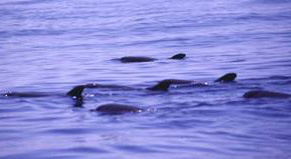Pygmy Killer Whale (Feresa attenuata)
Status | Taxonomy | Species Description | Habitat | Distribution |
Population Trends | Threats | Conservation Efforts | Regulatory Overview |
Key Documents | More Info
Status
MMPA - Pygmy killer whales, like all marine mammals, are protected under the MMPA.
Taxonomy
Kingdom: Animalia
Phylum: Chordata
Class: Mammalia
Order: Cetacea
Family: Delphinidae
Genus: Feresa
Species: attenuata
Species Description
Pygmy killer whales are small members of the dolphin group. They can reach a length of 8.5 feet (2.6 m) and weight of 380 pounds (170 kg).
They have a small head with a rounded melon that extends in front of the mouth and there is no discernable beak. Their dorsal fin is relatively large and tall and is located behind the mid-back. They have relatively long pointed, tapering flippers (pectoral fins). Body color is dark with some small white areas on the lips and belly.
Reproductive biology is poorly known in this species.
Pygmy killer whales usually occur in groups of 50 or less. Both sexes may remain in their birth groups. They are generally less active than other oceanic dolphins; frequently they are seen "logging"--resting in groups at the surface with all animals oriented the same way.
They apparently feed primarily on squids and fishes.
Habitat
They prefer deeper areas of warmer tropical and subtropical waters where their prey are concentrated.
 Pygmy Killer Whale Range Map (click for larger view PDF) |
Distribution
Pygmy killer whales are found primarily in deep waters throughout tropical and subtropical areas of the world. There are three recognized stocks in the U.S.: Hawaii, Northern Gulf of Mexico, and Western North Atlantic.
Population Trends
Current population sizes for the different U.S. stocks are: Hawaii - 817; Western North Atlantic - unknown, only one sighting has been made, but these did not occur during population size surveys; Northern Gulf of Mexico - 410. There are not enough data to determine trends in these stocks. See below for links to the most recent stock assessments for the U.S. populations.
Threats
A few are "taken" in drive fisheries and there is some, probably small, bycatch in gillnet fisheries. There is no reported bycatch from U.S. fisheries. Only a few strandings are known.
Conservation Efforts
Pygmy killer whales are considered Data Deficient in the IUCN Redlist ![]() . There are no known conservation efforts directed specifically at this species as they are poorly known and have few fishery interactions or other known threats.
. There are no known conservation efforts directed specifically at this species as they are poorly known and have few fishery interactions or other known threats.
Regulatory Overview
This species is protected under the Marine Mammal Protection Act of 1972 as amended.
Key Documents
(All documents are in PDF format.)
| Title | Federal Register | Date |
|---|---|---|
| Stock Assessment Reports | n/a | various |
